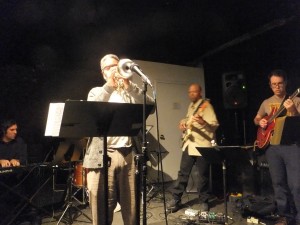Date: December 19, 2012
Venue: the STONE
Review by Dawoud Kringle
On a cold night close to Christmas, and close to December 21, bassist/composer/ bandleader Damon Banks appeared at The Stone.
Damon Banks is a well known bassist in New York who has worked with Miki Howard, Hassan Hakmoun, Karsh Kale, George Benson, SoSaLa, and many others. On this night, he was joined by Graham Haynes (trumpet), Manu Koch (keys), Bruce Cox (drums), and Brian Prunka (guitar and oud. Prunka also plays with Banks in SoSaLa and leads his own band Nashaz).
After a brief sound check, and some pre gig scurrying, Damon said “Let’s do this.”
A heavily processed bass guitar accompanied by floating cymbals invoked the first some. A bass groove reminiscent of 70s funk began. Trumpet cut above it all with a clear, sad melody. The song was one of those songs that speaks if the vibe of NYC life: that if facing the struggle of surviving in the particular kind if tough environment unique to NYC.
The song faded, and without break, an ominous, spacey prelude to the next song began. Melodies and harmonies coalesced into an expiration of harmonic territories. The drums played no groove; they recited poetry.
They followed with a hypnotic 6/4 (occasionally adding a 2/4) groove that reminded my almost if late period Meshell, and of Weather Report. The keys exited their solo with a Rhodes sound. The trumpet took a break.
Then the guitar played the oud. His started with the oud playing that earthy vibe that only an oud can produce. It was accompanied by a sparse pad on the keys. He started a groove. The bass and drums took the groove and the oud invoked a melody that bridged Somalia and NYC jazz. He finished with what can best be described as a North African blues.
The trumpet returned from exile and rejoined the band. A heavy down beat with crystalline keyboard chords provided the backdrop for a Miles Davis like confrontation /stance (sometimes this is the only way to describe The Miles Legacy.) but there was still the sense of friendship and lack of animosity: all were welcome, if they could hang…
A ballad in the Miles tradition (with muted cornet) followed. There was no street attitude here; only beauty. An intimacy and sincerity that was almost shocking.
The next song was dedicated to anyone unjustly killed in…wherever: the nation still mourning the recent massacre in Connecticut. They played “Taps.” They naturally took considerable liberties with the harmonic structure and the melody, but none of the solemn vibe was lost – in fact, it had a sincerity that military bands could never hope to create: it was real. Then a grove unfolded. The guitar offered a sparse Scofield like exploration of the piece.
A Latin jazz Groove came up. This is the essence of Manhattan’s lower east side jazz; its influence is inescapable. The drums took a brief solo. The band returned to the song; and the band drove the ding to new, joyful life; the guitar and trumpet weaving in and our of each other’s vector like a double helix.
Damon and company at the Stone sported a friendly atmosphere; a gathering of “The Cats. The band’s presence was the style almost all jazz musicians have: that of casually being able to pull off musical miracles as easily as breathing.
All NYC musicians have this attitude. We’ve earned it.


